Boil Black Cusine Art Is for Tea or Coffee
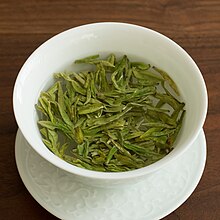 Longjing light-green tea being infused in a gaiwan | |
| Blazon | Hot or cold beverage |
|---|---|
| Country of origin | China[1] |
| Introduced | First recorded in China in 59 BC, though probably originated earlier[2] |
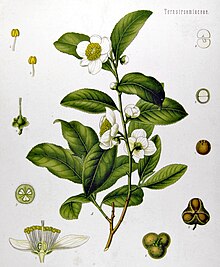

Tea is an effluvious beverage prepared by pouring hot or boiling h2o over cured or fresh leaves of Camellia sinensis, an evergreen shrub native to Red china, India and other East Asian countries.[iii] Tea is also rarely fabricated from the leaves of Camellia taliensis.[4] [five] [6] After water, it is the almost widely consumed drinkable in the world.[7] There are many different types of tea; some take a cooling, slightly biting, and severe flavour,[viii] while others have vastly different profiles that include sweet, nutty, floral, or grassy notes. Tea has a stimulating effect in humans primarily due to its caffeine content.[9]
Tea plants are native to East Asia and probably originated in the borderlands of southwestern China and northern Burma.[x] [11] [12] An early credible record of tea drinking dates to the third century Advertisement, in a medical text written past Hua Tuo.[xiii] It was popularised as a recreational beverage during the Chinese Tang dynasty, and tea drinking later on spread to other East Asian countries. Portuguese priests and merchants introduced information technology to Europe during the 16th century.[14] During the 17th century, drinking tea became fashionable among the English, who started to plant tea on a large scale in India.
The term herbal tea refers to drinks not fabricated from Camellia sinensis. They are the infusions of fruit, leaves, or other institute parts, such as steeps of rosehip, chamomile, or rooibos. These may be called tisanes or herbal infusions to prevent confusion with "tea" made from the tea plant.
Etymology [edit]

The etymology of the various words for tea reflects the history of transmission of tea drinking culture and trade from China to countries around the globe.[fifteen] Nearly all of the words for tea worldwide fall into three broad groups: te, cha and chai, present in English as tea, cha or char, and chai. The earliest of the three to enter English is cha, which came in the 1590s via the Portuguese, who traded in Macao and picked up the Cantonese pronunciation of the word.[16] [17] The more mutual tea form arrived in the 17th century via the Dutch, who acquired information technology either indirectly from the Malay teh, or direct from the tê pronunciation in Min Chinese.[sixteen] The third form chai (significant "spiced tea") originated from a northern Chinese pronunciation of cha, which travelled overland to Cardinal Asia and Persia where it picked upward a Persian ending yi.
Origin and history [edit]
Botanical origin [edit]
Tea plants are native to Eastern asia and probably originated in the borderlands of southwestern Prc and north Burma.[10]
Chinese (small-foliage) type tea (C. sinensis var. sinensis) may accept originated in southern China perhaps with hybridization of unknown wild tea relatives. Even so, since at that place are no known wild populations of this tea, its origin is speculative.[18] [19]
Given their genetic differences forming distinct clades, Chinese Assam-type tea (C. sinensis var. assamica) may have 2 dissimilar parentages – ane being found in southern Yunnan (Xishuangbanna, Pu'er City) and the other in western Yunnan (Lincang, Baoshan). Many types of Southern Yunnan Assam tea take been hybridized with the closely related species Camellia taliensis. Unlike Southern Yunnan Assam tea, Western Yunnan Assam tea shares many genetic similarities with Indian Assam-type tea (besides C. sinensis var. assamica). Thus, Western Yunnan Assam tea and Indian Assam tea both may accept originated from the same parent establish in the expanse where southwestern Communist china, Indo-Burma, and Tibet meet. However, as the Indian Assam tea shares no haplotypes with Western Yunnan Assam tea, Indian Assam tea is likely to have originated from an independent domestication. Some Indian Assam tea appears to have hybridized with the species Camellia pubicosta.[18] [19]
Assuming a generation of 12 years, Chinese small-leaf tea is estimated to have diverged from Assam tea effectually 22,000 years ago, while Chinese Assam tea and Indian Assam tea diverged ii,800 years ago. The departure of Chinese small-leafage tea and Assam tea would represent to the last glacial maximum.[18] [19]
Early tea drinking [edit]

A 19th-century Japanese painting depicting Shennong: Chinese legends credit Shennong with the invention of tea.[20]
People in ancient Asia ate tea for centuries, perhaps even millennia, before e'er consuming information technology equally a beverage. They would nibble on the leaves raw, add them to soups or greens, or ferment them and chew similar betel.[21] [ page needed ] [22]
Tea drinking may have begun in the region of Yunnan, where it was used for medicinal purposes. It is also believed that in Sichuan, "people began to boil tea leaves for consumption into a concentrated liquid without the addition of other leaves or herbs, thereby using tea as a bitter still stimulating drink, rather than as a medicinal concoction."[12]
Chinese legends attribute the invention of tea to the mythical Shennong (in central and northern China) in 2737 BC, although evidence suggests that tea drinking may have been introduced from the southwest of China (Sichuan/Yunnan area).[20] The earliest written records of tea come from China. The word tú 荼 appears in the Shijing and other aboriginal texts to signify a kind of "bitter vegetable" ( 苦菜 ), and it is possible that it referred to many different plants such as sow thistle, chicory, or smartweed,[23] as well as tea.[24] In the Chronicles of Huayang, it was recorded that the Ba people in Sichuan presented tu to the Zhou king. The Qin later on conquered the state of Ba and its neighbour Shu, and according to the 17th century scholar Gu Yanwu who wrote in Ri Zhi Lu ( 日知錄 ): "It was after the Qin had taken Shu that they learned how to drink tea."[ii] Another possible early reference to tea is found in a letter written by the Qin Dynasty general Liu Kun who requested that some "real tea" to be sent to him.[25]
The primeval known physical show[26] of tea was discovered in 2016 in the mausoleum of Emperor Jing of Han in 11'an, indicating that tea from the genus Camellia was drunkard past Han dynasty emperors every bit early equally the second century BC.[27] The Han dynasty work, "The Contract for a Youth", written past Wang Bao in 59 BC,[28] contains the starting time known reference to humid tea. Amidst the tasks listed to be undertaken past the youth, the contract states that "he shall eddy tea and fill the utensils" and "he shall buy tea at Wuyang".[2] The commencement record of tea cultivation is also dated to this period, during which tea was cultivated on Meng Mountain ( 蒙山 ) most Chengdu.[29] Another early apparent record of tea drinking dates to the third century Advertizement, in a medical text by Hua Tuo, who stated, "to drinkable bitter t'u constantly makes one think better."[30] However, before the mid-8th century Tang dynasty, tea-drinking was primarily a southern Chinese exercise.[31] Tea was disdained past the Northern dynasties aristocrats, who describe it equally a "slaves' drink", inferior to yogurt.[32] [33] It became widely pop during the Tang dynasty, when information technology was spread to Korea, Japan, and Vietnam. The Classic of Tea, a treatise on tea and its preparations, was written by Lu Yu in 762.
Developments [edit]

Tea with ingredients, Prc
Through the centuries, a variety of techniques for processing tea, and a number of unlike forms of tea, were developed. During the Tang dynasty, tea was steamed, and so pounded and shaped into cake class,[34] while in the Song dynasty, loose-leafage tea was developed and became popular. During the Yuan and Ming dynasties, unoxidized tea leaves were first stirred in a hot dry pan, so rolled and air-dried, a procedure that stops the oxidation process that would have turned the leaves night, thereby allowing tea to remain light-green. In the 15th century, oolong tea, in which the leaves are immune to partially oxidize earlier being heated in the pan, was developed.[31] Western tastes, however, favoured the fully oxidized black tea, and the leaves were allowed to oxidize farther. Yellow tea was an accidental discovery in the product of green tea during the Ming dynasty, when obviously careless practices immune the leaves to turn yellow, which yielded a different flavor.[35]
Worldwide spread [edit]
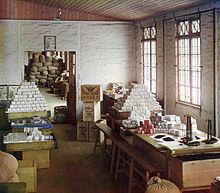
Tea was kickoff introduced to Western priests and merchants in China during the 16th century, at which time it was termed chá.[14] The earliest European reference to tea, written equally chiai, came from Delle navigationi eastward viaggi written by Venetian Giambattista Ramusio in 1545.[36] The first recorded shipment of tea by a European nation was in 1607 when the Dutch E India Company moved a cargo of tea from Macao to Java, and then two years later, the Dutch bought the first assignment of tea which was from Hirado in Nihon to be shipped to Europe.[37] Tea became a fashionable drink in The Hague in kingdom of the netherlands, and the Dutch introduced the drink to Germany, French republic, and across the Atlantic to New Amsterdam (New York).[38]
In 1567, Russian people came in contact with tea when the Cossack Atamans Petrov and Yalyshev visited China.[39] The Mongolian Khan donated to Tsar Michael I four poods (65–70 kg) of tea in 1638.[40] According to Jeremiah Curtin,[41] it was peradventure in 1636[42] that Vassili Starkov was sent as envoy to the Altyn Khan. He was given 250 pounds of tea as a souvenir to the tsar. Starkov at first refused, seeing no use for a load of dead leaves, simply the Khan insisted. Thus was tea introduced to Russia. In 1679, Russian federation concluded a treaty on regular tea supplies from Communist china via camel caravan in exchange for furs. It is today considered the de facto national beverage.

The Raymond, Hugh Mckay Commander. The first vessel directly from China to Hull on her arrival on 14 Oct 1843 with a cargo of tea
The first record of tea in English came from a letter written by Richard Wickham, who ran an East India Company function in Nippon, writing to a merchant in Macao requesting "the best sort of chaw" in 1615. Peter Mundy, a traveller and merchant who came across tea in Fujian in 1637, wrote, "chaa – only water with a kind of herb boyled in it".[43] [44] Tea was sold in a coffee house in London in 1657, Samuel Pepys tasted tea in 1660, and Catherine of Braganza took the tea-drinking habit to the English court when she married Charles 2 in 1662. Tea, still, was not widely consumed in the British Isles until the 18th century and remained expensive until the latter function of that period. English drinkers preferred to add sugar and milk to black tea, and black tea overtook green tea in popularity in the 1720s.[45] Tea smuggling during the 18th century led to the general public being able to afford and consume tea. The British government removed the tax on tea, thereby eliminating the smuggling merchandise, by 1785.[46] In Britain and Ireland, tea was initially consumed every bit a luxury item on special occasions, such equally religious festivals, wakes, and domestic piece of work gatherings. The price of tea in Europe savage steadily during the 19th century, especially after Indian tea began to arrive in large quantities; past the tardily 19th century tea had become an everyday beverage for all levels of society.[47] The popularity of tea played a office in historical events – the Tea Human action of 1773 provoked the Boston Tea Party that escalated into the American Revolution. The need to address the event of British trade arrears because of the trade in tea resulted in the Opium Wars. The Qing Kangxi Emperor had banned foreign products from beingness sold in China, decreeing in 1685 that all appurtenances bought from China must be paid for in silverish coin or bullion.[48] Traders from other nations and then sought to observe another product, in this case opium, to sell to China to earn back the silver they were required to pay for tea and other commodities. The subsequent attempts past the Chinese Government to curtail the merchandise in opium led to war.[49]
Chinese minor-foliage-type tea was introduced into India in 1836 by the British in an try to intermission the Chinese monopoly on tea.[50] In 1841, Archibald Campbell brought seeds of Chinese tea from the Kumaun region and experimented with planting tea in Darjeeling. The Alubari tea garden was opened in 1856, and Darjeeling tea began to exist produced.[51] In 1848, Robert Fortune was sent by the Honourable Due east India Company on a mission to Red china to bring the tea plant dorsum to Great Britain. He began his journey in high secrecy equally his mission occurred in the lull between the Beginning Opium War and the 2nd Opium War.[52] The Chinese tea plants he brought dorsum were introduced to the Himalayas, though most did not survive. The British had discovered that a dissimilar variety of tea was endemic to Assam and the northeast region of Republic of india, which was then hybridized with Chinese small-leafage-type tea. Using Chinese planting and cultivation techniques, the British colonial government established a tea industry by offer state in Assam to any European who agreed to cultivate it for export.[50] Tea was originally consumed only by Anglo-Indians; all the same, it became widely popular in India in the 1950s because of a successful advertising campaign past the Republic of india Tea Board.[50] The British introduced tea industry to Sri Lanka (then Ceylon) in 1867.[53]
Tillage and harvesting [edit]

Camellia sinensis is an evergreen plant that grows mainly in tropical and subtropical climates.[54] Some varieties can also tolerate marine climates and are cultivated equally far north as Cornwall in England,[55] Perthshire in Scotland,[56] Washington in the United States,[57] and Vancouver Island in Canada.[58] In the Southern Hemisphere, tea is grown as far south as Hobart in Tasmania[59] [60] and Waikato in New Zealand.[61]
Tea plants are propagated from seed and cuttings; about 4 to 12 years are needed for a found to bear seed and about three years before a new plant is fix for harvesting.[54] In addition to a zone 8 climate or warmer, tea plants require at least 127 cm (fifty in) of rainfall per yr and adopt acidic soils.[62] Many loftier-quality tea plants are cultivated at elevations of upwardly to ane,500 m (4,900 ft) above sea level. Though at these heights the plants grow more slowly, they acquire a better flavour.[63]
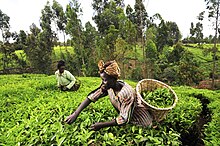
Women tea pickers in Kenya
Ii principal varieties are used: Camellia sinensis var. sinensis, which is used for most Chinese, Formosan and Japanese teas, and C. sinensis var. assamica, used in Pu-erh and well-nigh Indian teas (but not Darjeeling). Within these botanical varieties, many strains and modern clonal varieties are known. Leaf size is the chief benchmark for the nomenclature of tea plants, with three primary classifications being:[64] Assam type, characterised by the largest leaves; Mainland china type, characterised by the smallest leaves; and Cambodian type, characterised by leaves of intermediate size. The Cambodian-type tea (C. assamica subsp. lasiocaly) was originally considered a blazon of Assam tea. However, afterward genetic work showed that it is a hybrid between Chinese small-leaf tea and Assam-type tea.[65] Darjeeling tea likewise appears to be a hybrid between Chinese small-leaf tea and Assam-type large-leaf tea.[66]

A tea plant will grow into a tree of up to sixteen m (52 ft) if left undisturbed,[54] just cultivated plants are mostly pruned to waist peak for ease of plucking. As well, the short plants behave more new shoots which provide new and tender leaves and increment the quality of the tea.[67] Simply the top 2.5–v centimetres (ane–2 in) of the mature plant are picked. These buds and leaves are called 'flushes'.[68] A constitute will abound a new flush every 7 to fifteen days during the growing season. Leaves that are dull in evolution tend to produce meliorate-flavoured teas.[54] Several teas are available from specified flushes; for case, Darjeeling tea is available as first flush (at a premium price), 2d flush, monsoon and fall. Assam second affluent or "tippy" tea is considered superior to outset flush, because of the gold tips that announced on the leaves.
Pests that can afflict tea plants include mosquito bugs, genus Helopeltis, which are true bugs and non to be confused with dipterous insects of family unit Culicidae ('mosquitos'). Mosquito bugs tin damage leaves both by sucking constitute materials, and by the laying of eggs (oviposition) within the plant. Spraying with constructed insecticides may be accounted appropriate.[69] Other pests are Lepidopteran leaf feeders and various tea diseases.
Chemical composition [edit]
Physically speaking, tea has properties of both a solution and a suspension. It is a solution of all the water-soluble compounds that have been extracted from the tea leaves, such equally the polyphenols and amino acids, simply is a suspension when all of the insoluble components are considered, such as the cellulose in the tea leaves.[70] Tea infusions are among most consumed beverages globally.[71]
Caffeine constitutes nearly 3% of tea's dry out weight, translating to between thirty and 90 milligrams per 250-millilitre (8+ one⁄two US fl oz) cup depending on the type, brand,[72] and brewing method.[73] A study establish that the caffeine content of 1 gram of black tea ranged from 22 to 28 mg, while the caffeine content of one gram of green tea ranged from 11 to 20 mg, reflecting a significant difference.[74] Tea too contains small amounts of theobromine and theophylline, which are stimulants, and xanthines similar to caffeine.[75]

Fresh tea leaves in various stages of growth
Black and green teas contain no essential nutrients in significant amounts, with the exception of the dietary mineral manganese, at 0.v mg per cup or 26% of the Reference Daily Intake (RDI).[76] Fluoride is sometimes present in tea; certain types of "brick tea", fabricated from old leaves and stems, have the highest levels, enough to pose a wellness risk if much tea is drunk, which has been attributed to loftier levels of fluoride in soils, acidic soils, and long brewing.[77]
The astringency in tea can exist attributed to the presence of polyphenols. These are the near abundant compounds in tea leaves, making upwards 30–xl% of their composition.[78] Polyphenols include flavonoids, epigallocatechin gallate (EGCG), and other catechins.[79] [80] Although in that location has been preliminary clinical enquiry on whether green or black teas may protect against various human being diseases, at that place is no evidence that tea polyphenols have any event on wellness or lowering disease risk.[81] [82]
Processing and classification [edit]
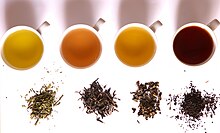
Teas of different levels of oxidation (L to R): dark-green, yellow, oolong, and black
Tea is generally divided into categories based on how it is processed.[83] At least six unlike types are produced:
- White: wilted and unoxidized;
- Yellow: unwilted and unoxidized simply allowed to yellowish;
- Dark-green: unwilted and unoxidized;
- Oolong: wilted, bruised, and partially oxidized;
- Black: wilted, sometimes crushed, and fully oxidized (chosen 紅茶 [hóngchá], "red tea" in Chinese and other Eastward Asian tea culture);
- Post-fermented (Dark): greenish tea that has been allowed to ferment/compost (called Pu'er if from the Yunnan district of South-Western Mainland china or 黑茶 [hēichá] "black tea" in Chinese tea civilisation).
After picking, the leaves of C. sinensis soon begin to wilt and oxidize unless immediately dried. An enzymatic oxidation procedure triggered by the plant's intracellular enzymes causes the leaves to turn progressively darker equally their chlorophyll breaks down and tannins are released. This darkening is stopped at a predetermined phase by heating, which deactivates the enzymes responsible. In the production of black teas, halting past heating is carried out simultaneously with drying. Without careful moisture and temperature control during manufacture and packaging, growth of undesired molds and bacteria may make tea unfit for consumption.
Boosted processing and additives [edit]

Common processing methods of tea leaves
Later on basic processing, teas may be altered through boosted processing steps earlier being sold[84] and is ofttimes consumed with additions to the basic tea leaf and water added during grooming or drinking. Examples of additional processing steps that occur earlier tea is sold are blending, flavouring, scenting, and decaffeination of teas. Examples of additions added at the bespeak of consumption include milk, saccharide and lemon.
Tea blending is the combination of unlike teas together to achieve the concluding product. Such teas may combine others from the same cultivation area or several unlike ones. The aim is to obtain consistency, amend gustatory modality, higher price, or some combination of the iii.
Flavoured and scented teas add together aromas and flavours to the base tea. This can be accomplished through straight calculation flavouring agents, such every bit ginger, cloves, mint leaves, cardamom, bergamot (found in Earl Grayness), vanilla, and spearmint. Alternatively, because tea easily retains odours, it tin be placed in proximity to an effluvious ingredient to absorb its aroma, as in traditional jasmine tea.[85]

Black tea is frequently taken with milk
The addition of milk to tea in Europe was kickoff mentioned in 1680 past the epistolist Madame de Sévigné.[86] Many teas are traditionally drunkard with milk in cultures where dairy products are consumed. These include Indian masala chai and British tea blends. These teas tend to exist very hearty varieties of black tea which tin can exist tasted through the milk, such as Assams, or the Eastward Friesian alloy. Milk is thought to neutralise remaining tannins and reduce acerbity.[87] [88] The Han Chinese practice not ordinarily beverage milk with tea just the Manchus do, and the aristocracy of the Qing Dynasty of the Chinese Empire connected to practice so. Hong Kong-manner milk tea is based on British habits. Tibetans and other Himalayan peoples traditionally drinkable tea with milk or yak butter and common salt. In Eastern European countries, Russian federation and Italy, tea is unremarkably served with lemon juice. In Poland, tea is traditionally served with a piece of lemon and is sweetened with either sugar or dearest; tea with milk is called a bawarka ("Bavarian fashion") in Smooth and is also widely popular.[89] In Australia, tea with milk is known equally "white tea".
The lodge of steps in preparing a cup of tea is a much-debated topic and can vary widely between cultures or even individuals. Some say it is preferable to add the milk to the cup before the tea, every bit the high temperature of freshly brewed tea tin can denature the proteins found in fresh milk, like to the modify in taste of UHT milk, resulting in an inferior-tasting drink.[90] Others insist it is better to add the milk to the cup after the tea, every bit black tea is oft brewed as close to humid every bit possible. The addition of milk chills the drinkable during the crucial brewing phase, if brewing in a cup rather than using a pot, meaning the delicate flavour of a practiced tea cannot exist fully appreciated. By adding the milk afterwards, it is easier to dissolve saccharide in the tea and also to ensure the desired amount of milk is added, as the colour of the tea can exist observed.[91] Historically, the order of steps was taken every bit an indication of grade: only those wealthy enough to afford adept-quality porcelain would be confident of its being able to cope with being exposed to boiling water unadulterated with milk.[92] College temperature difference means faster heat transfer, so the before milk is added, the slower the potable cools. A 2007 study published in the European Heart Periodical found sure beneficial effects of tea may be lost through the addition of milk.[93]
Chinese teaware tools [edit]

A set of Chinese teaware tools
- Tea caddy - a jar used for storing tea leaves. Tea caddies are normally made of bamboo, glass or forest. Tea caddies with a sealed lid keep tea leaves dry.
- Tea scoop - used to collect tea leaves from a tea caddy. At the same fourth dimension, it has the capability of measuring the amount of tea leaves that take been taken out.
- Fan-shaped tea plate - used to view dried tea leaves.
- Aroma cup - designed to enhance the enjoyment of the fragrance of tea.
- Gaiwan set up includes three parts: a hat, a bowl, and a saucer. Typically, it is fabricated of ceramic, zisha, or glass. This device is used to pour the brewed tea into a tea cup or a fairness cup.
- Fairness loving cup - used for pouring the brewed tea into the Aroma loving cup evenly to ensure the consistency of the brewed tea.[94]
Tea culture [edit]

Drinking tea is often believed to result in calm alertness;[95] information technology contains 50-theanine, theophylline, and leap caffeine[8] (sometimes called theine). Decaffeinated brands are as well sold. While herbal teas are also referred to as tea, most of them practise not contain leaves from the tea plant. While tea is the second most consumed beverage on World afterwards h2o, in many cultures it is also consumed at elevated social events, such as the tea political party.
Tea ceremonies have arisen in dissimilar cultures, such as the Chinese and Japanese traditions, each of which employs certain techniques and ritualised protocol of brewing and serving tea for enjoyment in a refined setting. I form of Chinese tea anniversary is the Gongfu tea anniversary, which typically uses small Yixing clay teapots and oolong tea.

A immature Bengali boy drinking tea with block
In the United kingdom of great britain and northern ireland, 63% of people drink tea daily.[96] It is customary for a host to offer tea to guests soon subsequently their inflow. Tea is consumed both at home and outside the habitation, frequently in cafés or tea rooms. Afternoon tea with cakes on fine porcelain is a cultural stereotype. In southwest England, many cafés serve a cream tea, consisting of scones, clotted cream, and jam alongside a pot of tea. In some parts of U.k. and Bharat, 'tea' may as well refer to the evening meal.
Ireland, as of 2016, was the 2d-biggest per capita consumer of tea in the earth.[97] Local blends are the well-nigh popular in Ireland, including Irish breakfast tea, using Rwandan, Kenyan and Assam teas. The almanac national average of tea consumption in Ireland is 2.7 kg to 4 kg per person. Tea in Ireland is usually taken with milk or sugar and brewed longer for a stronger taste.[98]
Turkish tea is an important part of that country'due south cuisine and is the most commonly consumed hot drink, despite the country'south long history of coffee consumption. In 2004, Turkey produced 205,500 tonnes of tea (6.four% of the world'south total tea production), which made it one of the largest tea markets in the globe,[99] with 120,000 tons being consumed in Turkey and the rest being exported.[100] In 2010, Turkey had the highest per capita consumption in the world at 2.vii kg.[101] Equally of 2013, the per-capita consumption of Turkish tea exceeds ten cups per mean solar day and xiii.8 kg per year.[102] Tea is grown mostly in Rize Province on the Black Sea declension.[103]
Russia has a long, rich tea history dating to 1638 when tea was introduced to Tsar Michael. Social gatherings were considered incomplete without tea, which was traditionally brewed in a samovar.[104]
In Islamic republic of pakistan, both black and dark-green teas are popular and are known locally equally sabz chai and kahwah, respectively. The pop green tea is often served afterwards every repast in the Pashtun belt of Balochistan and in Khyber Pakhtunkhwa. In key and southern Punjab and the metropolitan Sindh region of Pakistan, tea with milk and sugar (sometimes with pistachios, cardamom, etc.), commonly referred to as chai, is widely consumed. Information technology is the most common beverage of households in the region. In the northern Pakistani regions of Chitral and Gilgit-Baltistan, a salty, buttered Tibetan-style tea is consumed.

Indian tea culture is strong; the drink is the nigh popular hot beverage in the country. It is consumed daily[105] in nearly all houses, offered to guests, consumed in high amounts in domestic and official surroundings, and is made with the addition of milk with or without spices, and commonly sweetened. It is sometimes served with biscuits to exist dipped in the tea and eaten before consuming the tea. More oftentimes than not, it is drunk in "doses" of small cups (referred to equally "cutting" chai if sold at street tea vendors) rather than one large cup.
In Burma (Myanmar), tea is consumed not only every bit hot drinks, merely also as sugariness tea and green tea known locally as laphet-yay and laphet-yay-gyan, respectively. Pickled tea leaves, known locally as lahpet, are likewise a national delicacy. Pickled tea is usually eaten with roasted sesame seeds, crispy fried beans, roasted peanuts and fried garlic chips.[106]
In Mali, gunpowder tea is served in series of three, starting with the highest oxidisation or strongest, unsweetened tea, locally referred to as "strong similar expiry", followed by a 2nd serving, where the same tea leaves are boiled again with some sugar added ("pleasant as life"), and a tertiary i, where the same tea leaves are boiled for the third time with notwithstanding more sugar added ("sweet as dearest"). Light-green tea is the central ingredient of a distinctly Malian custom, the "Grin", an informal social gathering that cuts across social and economic lines, starting in front of family unit compound gates in the afternoons and extending late into the night, and is widely popular in Bamako and other large urban areas.[ citation needed ]
In the U.s., eighty% of tea is consumed as iced tea.[107] Sweet tea is native to the southeastern U.S. and is iconic in its cuisine.[108]
-

Turkish tea served in a typical small glass and corresponding plate
-
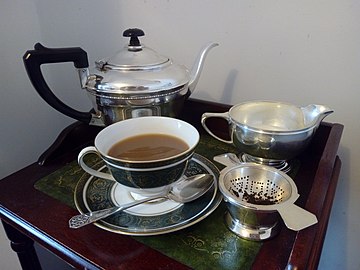
English language teaware
-

Indian Masala tea
-

South Indian woman, preparing a cup of morning tea in the traditional South Indian mode.
Production [edit]
Tea is mainly grown in Asia and Africa, though it is also grown in South America and around the Black and Caspian Seas. The 4 biggest tea-producing countries are China, India, Kenya and Sri Lanka, together representing 75% of world tea production. Smaller hubs of production include such places as São Miguel Isle, Azores, in Portugal, and Guria, in Georgia. In 2019, global production of tea was half-dozen.five one thousand thousand tonnes, led by China with 43% and India with 22% of the world total. Republic of kenya, Sri Lanka, and Vietnam were secondary producers.[109]
| Country | Million Tonnes |
|---|---|
| | 2.8 |
| | one.4 |
| | 0.46 |
| | 0.30 |
| | 0.27 |
| World | 6.five |
| Source: FAOSTAT of the United Nations[109] | |
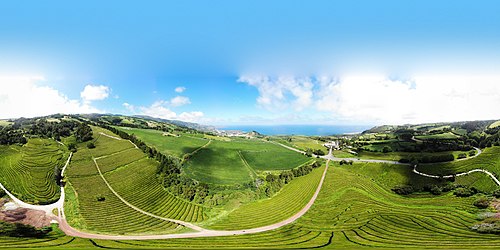
Economic science [edit]

Tea is the most popular manufactured potable consumed in the world, equaling all others – including coffee, soft drinks, and alcohol – combined.[7] Most tea consumed exterior East asia is produced on big plantations in the hilly regions of Bharat and Sri Lanka and is destined to be sold to big businesses. Opposite this big-scale industrial production are many small "gardens," sometimes minuscule plantations, that produce highly sought-after teas prized by gourmets. These teas are both rare and expensive and tin be compared to some of the almost expensive wines in this respect.
Bharat is the world'southward largest tea-drinking nation,[110] although the per capita consumption of tea remains a pocket-size 750 grams (26 oz) per person every twelvemonth. Turkey, with 2.5 kilograms (5 lb 8 oz) of tea consumed per person per year, is the globe'southward greatest per capita consumer.[111]
Labor and consumer safe problems [edit]
Tests of commercially popular teas accept detected residues of banned toxic pesticides.[112] [113]
Tea production in Kenya, Republic of malaŵi, Rwanda, Tanzania, and Republic of uganda has been reported to make use of child labor according to the U.S. Department of Labor's List of Goods Produced by Child Labor or Forced Labor. [114] Workers who choice and pack tea on plantations in developing countries tin can face up harsh working weather condition and may earn below the living wage.[115]
Certification [edit]
Several bodies independently certify the production of tea, such every bit Rainforest Alliance, Fairtrade, UTZ Certified, and Organic. From 2008 to 2016, sustainability standards-certified tea production experienced a compound almanac growth rate of almost 35%, accounting for at least xix% of overall tea production. In 2016, at to the lowest degree one.fifteen million tonnes of sustainably certified tea was produced, valued at U.s.$two billion.[116]
Rainforest Alliance certified tea is sold by Unilever brands Lipton and PG Tips in Western Europe, Australia and the U.S. Fairtrade certified tea is sold by a large number of suppliers around the globe. UTZ Certified tea is sold by Pickwick tea.
Production of organic tea has risen since its introduction in 1990 at Rembeng, Kondoli Tea Estate, Assam.[117] vi,000 tons of organic tea were sold in 1999.[118]
Packaging [edit]
Tea bags [edit]
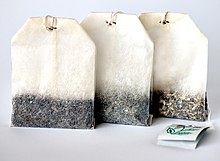
In 1907, American tea merchant Thomas Sullivan began distributing samples of his tea in small bags of silk with a drawstring. Consumers noticed they could merely leave the tea in the bag and reuse it with fresh tea. Still, the potential of this distribution and packaging method would not exist fully realised until afterwards on. During World War Ii, tea was rationed in the United Kingdom. In 1953, after rationing in the United kingdom of great britain and northern ireland ended, Tetley launched the tea pocketbook to the Britain, and information technology was an firsthand success.
The "pyramid tea bag" (or sachet), introduced by Lipton[119] and PG Tips/Scottish Blend in 1996,[120] attempts to accost one of the connoisseurs' arguments confronting newspaper tea numberless past fashion of its three-dimensional tetrahedron shape, which allows more room for tea leaves to expand while steeping.[ commendation needed ] [121] However, some types of pyramid tea bags have been criticised as being environmentally unfriendly, since their synthetic material is not every bit biodegradable equally loose tea leaves and paper tea bags.[122]
Loose tea [edit]

A alloy of loose-leaf black teas
The tea leaves are packaged loosely in a canister, newspaper pocketbook, or other container such equally a tea chest. Some whole teas, such as rolled gunpowder tea leaves, which resist crumbling, are vacuum-packed for freshness in aluminised packaging for storage and retail. The loose tea is individually measured for employ, allowing for flexibility and flavour command at the expense of convenience. Strainers, tea balls, tea presses, filtered teapots, and infusion bags prevent loose leaves from floating in the tea and over-brewing. A traditional method uses a three-piece lidded teacup called a gaiwan, the lid of which is tilted to decant the tea into a dissimilar cup for consumption.
Compressed tea [edit]
Compressed tea (such as pu-erh) is produced for convenience in transport, storage, and ageing. It can usually be stored longer without spoilage than loose leaf tea. Compressed tea is prepared past loosening leaves from the cake using a small knife, and steeping the extracted pieces in h2o. During the Tang dynasty, as described by Lu Yu, compressed tea was ground into a pulverization, combined with hot water, and ladled into bowls, resulting in a "frothy" mixture.[123] In the Song dynasty, the tea powder would instead be whisked with hot water in the bowl. Although no longer practiced in Mainland china today, the whisking method of preparing powdered tea was transmitted to Japan past Zen Buddhist monks, and is still used to prepare matcha in the Japanese tea ceremony.[124]
Compressed tea was the well-nigh popular class of tea in China during the Tang dynasty.[125] By the beginning of the Ming dynasty, information technology had been displaced by loose-leaf tea.[126] Information technology remains pop, however, in the Himalayan countries and Mongolian steppes. In Mongolia, tea bricks were ubiquitous enough to be used every bit a grade of currency. Among Himalayan peoples, compressed tea is consumed by combining it with yak butter and salt to produce butter tea.[127]
Instant tea [edit]
"Instant tea", like to freeze-dried instant coffee and an culling to brewed tea, can exist consumed either hot or cold. Instant tea was developed in the 1930s, with Nestlé introducing the first commercial product in 1946, while Redi-Tea debuted instant iced tea in 1953. Additives such equally chai, vanilla, honey or fruit, are popular, equally is powdered milk.
During the 2nd World War British and Canadian soldiers were issued an instant tea known as "compo" in their blended ration packs. These blocks of instant tea, powdered milk, and sugar were not always well received. As Royal Canadian Artillery Gunner, George C Blackburn observed:
But, unquestionably, the characteristic of Compo rations destined to exist remembered across all others is Compo tea...Directions say to "sprinkle powder on heated h2o and bring to the boil, stirring well, 3 heaped teaspoons to one pint of water." Every possible variation in the grooming of this tea was tried, simply...it e'er ended up the same way. While still too hot to drink, it is a good-looking cup of strong tea. Even when information technology becomes just cool enough to be sipped gingerly, it is nevertheless a expert-tasting cup of tea, if you lot like your tea potent and sweetness. But let it cool enough to exist quaffed and enjoyed, and your lips will exist coated with a sticky scum that forms across the surface, which if left undisturbed will become a leathery membrane that tin can exist wound around your finger and flipped away...[128]
Bottled and canned tea [edit]
Canned tea is sold prepared and ready to drink. It was introduced in 1981 in Japan. The commencement bottled tea was introduced past an Indonesian tea company, PT. Sinar Sosro in 1969 with the brand name Teh Botol Sosro (or Sosro bottled tea).[129] In 1983, Swiss-based Bischofszell Food Ltd. was the first company to bottle iced tea on an industrial scale.[130]
Storage [edit]
Storage conditions and blazon make up one's mind the shelf life of tea; that of black teas is greater than that of green teas. Some, such as flower teas, may final but a month or so. Others, such every bit pu-erh, better with age. To remain fresh and prevent mold, tea needs to be stored away from heat, calorie-free, air, and moisture. Tea must exist kept at room temperature in an air-tight container. Black tea in a bag within a sealed opaque canister may proceed for 2 years. Green tea deteriorates more rapidly, usually in less than a year. Tightly rolled gunpowder tea leaves keep longer than the more open-leafed Chun Mee tea.
Storage life for all teas can be extended by using desiccant or oxygen-absorbing packets, vacuum sealing, or refrigeration in air-tight containers (except greenish tea, where discrete utilize of refrigeration or freezing is recommended and temperature variation kept to a minimum).[131]
Gallery [edit]
-
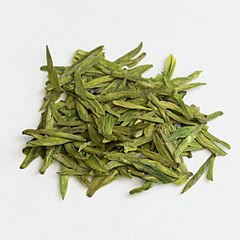
-

-

-

Loose dried tea leaves
-

-

A spicy Thai salad fabricated with young, fresh tea leaves
-

Milk tea
-
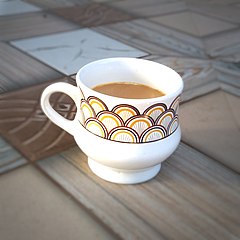
tea
See also [edit]
- Tea leaf grading
- Chifir', Russian extra-strong tea mash
- Frederick John Horniman
- Kombucha, potable produced from bacteria and yeast grown on tea
- List of Chinese teas
- List of hot beverages
- List of national drinks
- Listing of tea companies
- Herbal tea
- Phenolic content in tea
- Tea classics, influential historical monographs of East Asian tea
- Indian Tea Association
- International Tea Day
References [edit]
Citations [edit]
- ^ Fuller, Thomas (21 April 2008). "A Tea From the Jungle Enriches a Placid Village". The New York Times. New York. p. A8. Archived from the original on fourteen Feb 2017. Retrieved 23 February 2017.
- ^ a b c Mair & Hoh 2009, pp. 29–30.
- ^ Martin, p. eight
- ^ "Laoshu Dianhong (Sometime Tree Yunnan)".
- ^ "Yunnan da Bai Silver Needles – Tea Trekker".
- ^ Liu et al. (2012)
- ^ a b Macfarlane, Alan; Macfarlane, Iris (2004). The Empire of Tea. The Overlook Press. p. 32. ISBN978-ane-58567-493-0.
- ^ a b Penelope Ody (2000). Complete Guide to Medicinal Herbs. New York: Dorling Kindersley Publishing. p. 48. ISBN978-0-7894-6785-0.
- ^ Cappelletti S, Piacentino D, Daria P, Sani G, Aromatario M (January 2015). "Caffeine: cognitive and physical operation enhancer or psychoactive drug?". Current Neuropharmacology. 13 (i): 71–88. doi:10.2174/1570159X13666141210215655. PMC4462044. PMID 26074744.
- ^ a b Yamamoto, T; Kim, M; Juneja, L R (1997). Chemical science and Applications of Greenish Tea. CRC Press. p. 4. ISBN978-0-8493-4006-2.
For a long time, botanists have asserted the dualism of tea origin from their observations that at that place exist distinct differences in the morphological characteristics between Assamese varieties and Chinese varieties... Hashimoto and Shimura reported that the differences in the morphological characteristics in tea plants are not necessarily the testify of the dualism hypothesis from the researches using the statistical cluster analysis method. In recent investigations, information technology has also been made articulate that both varieties take the same chromosome number (n=15) and can exist easily hybridised with each other. In addition, various types of intermediate hybrids or spontaneous polyploids of tea plants have been found in a broad surface area extending over the regions mentioned in a higher place. These facts may prove that the identify of origin of Camellia sinensis is in the area including the northern role of the Burma, Yunnan, and Sichuan districts of Cathay.
- ^ Mary Lou Heiss; Robert J. Heiss. The Story of Tea: A Cultural History and Drinking Guide .
Camellia sinensis originated in southeast Asia, specifically effectually the intersection of 29th parallel and 98th pinnacle, the point of confluence of the lands of southwest Cathay and Tibet
, north Burma, and northeast Republic of india, citing Mondal (2007) p. 519 - ^ a b Heiss & Heiss 2007, pp. half-dozen–vii.
- ^ Martin, p. 29: "beginning in the third century CE, references to tea seem more than credible, in particular those dating to the time of Hua T'o, a highly respected physician and surgeon"
- ^ a b Bennett Alan Weinberg; Bonnie Grand. Bealer (2001). The World of Caffeine: The Science and Civilization of the World's Most Pop Drug. Psychology Press. p. 63. ISBN978-0-415-92722-2. Archived from the original on 27 April 2016. Retrieved 10 January 2016.
- ^ Mair & Hoh 2009, pp. 262–264.
- ^ a b "tea". Online Etymology Lexicon.
- ^ Mair & Hoh 2009, p. 262.
- ^ a b c Meegahakumbura, MK; Wambulwa, MC; Thapa, KK; et al. (2016). "Indications for three independent domestication events for the tea plant (Camellia sinensis (50.) O. Kuntze) and new insights into the origin of tea germplasm in China and India revealed by nuclear microsatellites". PLOS ONE. 11 (five): e0155369. Bibcode:2016PLoSO..1155369M. doi:ten.1371/periodical.pone.0155369. PMC4878758. PMID 27218820.
- ^ a b c Meegahakumbura MK, Wambulwa MC, Li MM, et al. (2018). "Domestication origin and convenance history of the tea plant (Camellia sinensis) in China and India based on nuclear microsatellites and cpDNA sequence data". Frontiers in Found Science. eight: 2270. doi:10.3389/fpls.2017.02270. PMC5788969. PMID 29422908.
- ^ a b Yee, L.K., Tea's Wonderful History, The Chinese Historical and Cultural Projection, archived from the original on 3 August 2002, retrieved 17 June 2013,
year 1996–2012
- ^ George Van Driem (2019). Tale of Tea: A Comprehensive History of Tea: From Prehistoric Times to the Present Solar day. BRILL. ISBN978-9004386259.
- ^ Miranda Brown (2 March 2022). "The Medieval Influencer Who Convinced the World to Drinkable Tea—Non Eat It". Atlas Obscura.
- ^ Benn 2015, p. 22.
- ^ Mair & Hoh 2009, pp. 264–65.
- ^ Kit Boey Grub; Ione Kramer (1990). All the Tea in China. Sinolingua. pp. two–3. ISBN978-0-8351-2194-1. Archived from the original on 31 August 2016. Retrieved 21 May 2016.
- ^ "Archaeologists find world'south oldest tea cached with ancient Chinese emperor". The Independent. Independent Print Express. Archived from the original on 8 October 2017. Retrieved 15 September 2017.
- ^ Houyuan Lu; et al. (vii January 2016). "Earliest tea as evidence for ane branch of the Silk Road across the Tibetan Plateau". Nature. half-dozen: 18955. Bibcode:2016NatSR...618955L. doi:10.1038/srep18955. PMC4704058. PMID 26738699.
- ^ "World'due south oldest tea found in Chinese emperor's tomb". Phys.org. 28 January 2016. Archived from the original on 17 September 2016. Retrieved 22 July 2016.
The oldest written reference to tea is from the year 59 BC.
- ^ Mair & Hoh 2009, pp. thirty–31.
- ^ Bennett Alan Weinberg, Bonnie M. Bealer (2001). The World of Caffeine: The Science and Civilisation of the World's Well-nigh Popular Drug. Routledge. p. 28. ISBN978-0-415-92722-2. Archived from the original on 13 May 2016. Retrieved seven September 2015.
- ^ a b Benn 2015, p. 42.
- ^ Andrew Chittick (2020). The Jiankang Empire in Chinese and World History. Oxford University Press. pp. 75–76. ISBN9780190937546.
- ^ Scott Pearce; Audrey G. Spiro; Patricia Buckley Ebrey, eds. (2001). Civilisation and Power in the Reconstitution of the Chinese Realm, 200–600. Harvard University Asia Center. p. 22. ISBN0-674-00523-vi.
- ^ Mair & Hoh 2009, pp. 39–41.
- ^ Mair & Hoh 2009, p. 118.
- ^ Mair & Hoh 2009, p. 165.
- ^ Mair & Hoh 2009, p. 106.
- ^ Mair & Hoh 2009, p. 169.
- ^ "Russian Tea History". www.apollotea.com . Retrieved 28 May 2019.
- ^ Great Soviet Encyclopedia. Советская энциклопедия. 1978. pp. vol. 29, p. 11.
- ^ Jeremiah Curtin, A Journey to Southern Siberia, 1909, chapter one
- ^ Basil Dymytryshyn, Russia's Conquest of Siberia: A Documentary Record, 1985, volume one, document 48 (he was an envoy that year, simply the tea may have been given on a later visit to the Khan)
- ^ Paul Chrystal (2014). Tea: A Very British Beverage. Amberley Publishing Limited. ISBN978-1-4456-3360-2. Archived from the original on 28 September 2015. Retrieved 5 September 2015.
- ^ Peter Mundy Merchant Charlatan, 2011, ed. R.East. Pritchard, Bodleian Libraries, Oxford
- ^ "Tea". In Our Time. 29 April 2004. BBC Radio 4. Archived from the original on eleven April 2015. Retrieved 7 September 2015.
- ^ "A Social History of the Nation's Favourite Drinkable". Uk Tea Council. Archived from the original on 30 July 2009.
- ^ Lysaght, Patricia (1987). "When I makes Tea, I makes Tea: the case of Tea in Republic of ireland". Ulster Folklife. 33: 48–49.
- ^ Goldstone, Jack A. (2016). Revolution and Rebellion in the Early on Modernistic Earth: Population Change and State Breakup in England, France, Turkey, and China, 1600–1850; 25th Anniversary Edition. Routledge. ISBN978-i-315-40860-half dozen.
- ^ Lovell, Julia (2012). The Opium War: Drugs, Dreams and the Making of People's republic of china. Picador. ISBN978-1-4472-0410-7.
- ^ a b c Colleen Taylor Sen (2004). Nutrient Culture in India. Greenwood Publishing Group. p. 26. ISBN978-0-313-32487-i. Archived from the original on 24 April 2016. Retrieved 10 January 2016.
Ironically, information technology was the British who introduced tea drinking to India, initially to anglicized Indians. Tea did non become a mass drink in that location until the 1950s when the India Tea Board, faced with a surplus of low-class tea, launched an advertising campaign to popularize information technology in the n, where the drink of option was milk.
- ^ Mair & Hoh 2009, p. 214.
- ^ Sarah Rose (2010). For All the Tea in China. Penguin Books. pp. 1–5, 89, 122, 197.
- ^ "TED Example Studies – Ceylon Tea". American University, Washington, DC. Archived from the original on 23 February 2015. Retrieved 27 November 2013.
- ^ a b c d "Camellia Sinensis". Purdue University Centre for New Crops and Plants Products. 3 July 1996. Archived from the original on 24 September 2010. Retrieved 26 October 2010.
- ^ Levin, Angela (20 May 2013). "Welcome to Tregothnan, England'southward only tea estate". The Telegraph. Archived from the original on 14 December 2013. Retrieved 5 December 2013.
- ^ Hilpern, Kate (17 November 2014). "The world's offset Scottish tea (at £10 a cup)". The Independent. Archived from the original on eight October 2017. Retrieved 15 September 2017.
- ^ "Tea" (PDF). The Compendium of Washington Agriculture. Washington State Committee on Pesticide Registration. 2010. Archived from the original (PDF) on 10 August 2011. Retrieved 26 Apr 2011.
- ^ "Tea farm on Vancouver Isle, a Canadian outset". Vancouver Sunday. 5 May 2013. Archived from the original on 27 May 2014. Retrieved 26 May 2014.
- ^ Crawley, Jennifer (13 August 2013). "Tassie tea crop brewing". The Mercury (Hobart). Archived from the original on 11 March 2014.
- ^ "Episode 36 – Produce of Two Islands". The Cook and the Chef. Episode 36. 29 October 2008. ABC Australia. Archived from the original on xv Feb 2015. Retrieved 24 January 2015.
- ^ "Tea growing is tough going". The New Zealand Herald. 17 August 2013. Archived from the original on 28 January 2015. Retrieved 24 Jan 2015.
- ^ Rolfe, Jim & Cavern, Yvonne (2003). Camellias: A Applied Gardening Guide. Timber Printing. ISBN978-0-88192-577-7.
- ^ Pruess, Joanna (2006). Tea Cuisine: A New Arroyo to Flavoring Contemporary and Traditional Dishes. Globe Pequot. ISBN978-1-59228-741-3.
- ^ Mondal, T. K. (2007). "Tea". In Pua, E.C.; Davey, M.R. (eds.). Biotechnology in Agriculture and Forestry. Vol. 60: Transgenic Crops V. Berlin: Springer. pp. 519–20. ISBN978-3-540-49160-6.
- ^ Wambulwa, MC, MK Meegahakumbura, R Chalo, et al. 2016. Nuclear microsatellites reveal the genetic compages and convenance history of tea germplasm of Due east Africa. Tree Genetics & Genomes, 12.
- ^ Meegahakumbura MK, MC Wambulwa, Thou Li, et al. 2018. Domestication origin and breeding history of the tea found (Camellia sinensis) in Red china and Bharat based on nuclear microsatellites and cpDNA sequence information. Frontiers in Plant Science, 25.
- ^ Harler, Campbell Ronald (26 August 2014). "Tea production". Encyclopædia Britannica. Archived from the original on 30 Apr 2008. Retrieved 1 June 2007.
- ^ Hayes, Elizabeth Due south. (1980). Spices and Herbs: Lore and Cookery. Courier Dover Publications. p. 74. ISBN978-0-486-24026-viii.
- ^ Somnath Roy, Narayanannair Muraleedharan, Ananda Mukhapadhyay & Gautam Handique (24 April 2015). "The tea mosquito bug, Helopeltis theivora Waterhouse (Heteroptera: Miridae): its status, biology, environmental and direction in tea plantations". International Journal of Pest Management, 61:three. 61 (3): 179–197. doi:10.1080/09670874.2015.1030002. S2CID 83481846.
{{cite periodical}}: CS1 maint: uses authors parameter (link) - ^ Shoane, John (21 Nov 2008). "Tea Chemistry". The Teatropolitan Times. Archived from the original on 21 December 2016. Retrieved 16 December 2016.
- ^ Yang, Ziyin; Baldermann, Susanne; Watanabe, Naoharu (ane October 2013). "Recent studies of the volatile compounds in tea". Food Enquiry International. Tea – from bushes to mugs: composition, stability and health aspects. 53 (ii): 585–599. doi:10.1016/j.foodres.2013.02.011. ISSN 0963-9969.
- ^ Weinberg, Bennett Alan & Bealer, Bonnie 1000. (2001). The World of Caffeine: The Scientific discipline and Culture of the Globe's Most Popular Drug . Routledge. p. 228. ISBN978-0-415-92722-2.
- ^ Hicks MB, Hsieh YP, Bell LN (1996). "Tea preparation and its influence on methylxanthine concentration" (PDF). Food Inquiry International. 29 (3–4): 325–330. doi:10.1016/0963-9969(96)00038-v. Archived (PDF) from the original on 3 February 2013. Retrieved 13 May 2013.
- ^ Chatterjee A, Saluja M, Agarwal M, Alam M (2012). "Green tea: A boon for periodontal and general wellness". Periodical of Indian Lodge of Periodontology. 16 (2): 161–167. doi:10.4103/0972-124X.99256. PMC3459493. PMID 23055579.
- ^ Graham, HN (1992). "Green tea composition, consumption, and polyphenol chemistry". Preventive Medicine. 21 (3): 334–350. doi:10.1016/0091-7435(92)90041-f. PMID 1614995.
- ^ "Tea, brewed, prepared with tap h2o [black tea], one loving cup, USDA Nutrient Tables, SR-21". Conde Nast. 2014. Archived from the original on 26 October 2014. Retrieved 25 October 2014.
- ^ Fung KF, Zhang ZQ, Wong JW, Wong MH (1999). "Fluoride contents in tea and soil from tea plantations and the release of fluoride into tea liquor during infusion". Environmental Pollution. 104 (2): 197–205. doi:ten.1016/S0269-7491(98)00187-0.
- ^ Harbowy, ME (1997). "Tea Chemistry". Disquisitional Reviews in Plant Sciences. 16 (v): 415–480. doi:10.1080/713608154.
- ^ Ferruzzi, MG (2010). "The influence of beverage limerick on commitment of phenolic compounds from coffee and tea". Physiol Behav. 100 (i): 33–41. doi:x.1016/j.physbeh.2010.01.035. PMID 20138903. S2CID 207373774.
- ^ Williamson Yard, Dionisi F, Renouf One thousand (2011). "Flavanols from green tea and phenolic acids from coffee: critical quantitative evaluation of the pharmacokinetic data in humans later on consumption of single doses of beverages". Mol Nutr Food Res. 55 (6): 864–873. doi:10.1002/mnfr.201000631. PMID 21538847.
- ^ "Green Tea". National Center for Complementary and Integrative Wellness, US National Institutes of Wellness, Bethesda, Physician. 2014. Archived from the original on ii April 2015. Retrieved 25 October 2014.
- ^ "Summary of Qualified Health Claims Subject to Enforcement Discretion:Green Tea and Cancer". Food and Drug Administration, US Department of Wellness and Human Services. Oct 2014. Archived from the original on 15 October 2014. Retrieved 25 Oct 2014.
- ^ Liu Tong (2005). Chinese tea. Beijing: China Intercontinental Printing. p. 137. ISBN978-seven-5085-0835-one.
- ^ Tony, Gebely (October 2016). Tea: a user's guide. pp. Chapter 6. ISBN978-0-9981030-0-6. OCLC 965904874.
- ^ Gong, Wen. Lifestyle in China. 五洲传播出版社, 2007. Retrieved 23 October 2010, from [1]
- ^ "Cursory Guide to Tea". BriefGuides. 2006. Archived from the original on 22 Baronial 2006. Retrieved 7 November 2006.
- ^ "Some tea and vino may crusade cancer – tannin, found in tea and cherry-red wine, linked to esophageal cancer", Nutrition Health Review, 22 September 1990.
- ^ Tierra, Michael (1990). The Way of Herbs. Pocket Books. ISBN978-0-671-72403-0.
- ^ "Bawarka in English, translation, Shine-English Dictionary". Glosbe. Archived from the original on 24 Dec 2019. Retrieved 12 September 2019.
- ^ "How to make a perfect cuppa". BBC News. 25 June 2003. Archived from the original on 22 July 2006. Retrieved 28 July 2006.
- ^ Kruszelnicki, Karl S. (iii February 2000). "Biscuit Dunking Physics". world wide web.abc.net.au. Archived from the original on 11 June 2019. Retrieved 12 September 2019.
- ^ Dubrin, Beverly (2010). Tea Civilisation: History, Traditions, Celebrations, Recipes & More. Charlesbridge Publishing. p. 24. ISBN978-1-60734-363-9. Archived from the original on vi May 2016. Retrieved 10 January 2016.
- ^ Lorenz, Thousand.; Jochmann, N.; Von Krosigk, A.; Martus, P.; Baumann, G.; Stangl, K.; Stangl, Five. (2006). "Addition of milk prevents vascular protective effects of tea". European Heart Journal. 28 (2): 219–223. doi:10.1093/eurheartj/ehl442. PMID 17213230.
- ^ Sonia (5 Apr 2018). "9 Basic Chinese Teaware Tools & Accessories Y'all Should Know About | Hello Tea Loving cup". Retrieved 23 Apr 2022.
- ^ Dietz, Christina; Dekker, Matthijs (2017). "Effect of Green Tea Phytochemicals on Mood and Noesis". Current Pharmaceutical Design. 23 (xix): 2876–2905. doi:10.2174/1381612823666170105151800. PMID 28056735. Retrieved x June 2021.
- ^ "• UK: average cups of tea per day 2017 | Statista". world wide web.statista.com. Archived from the original on ii July 2019. Retrieved two July 2019.
- ^ "Annual per capita tea consumption worldwide as of 2016, by leading countries". Statista. 14 January 2016.
- ^ Pope, Conor. "Why we get a better cup in Ireland than all the tea in People's republic of china". The Irish Times . Retrieved 21 April 2020.
- ^ "World tea product reaches new highs". fao.org. Archived from the original on 28 Apr 2018. Retrieved 3 July 2014.
- ^ Nearly Turkey: Geography, Economics, Politics, Religion and Culture, Rashid and Resit Ergener, Pilgrims' Procedure, 2002, ISBN 0-9710609-vi-7, p. 41
- ^ "Capacity Building Program on International Trade" (PDF) (Press release). Ministry of Agronomics. Archived from the original (PDF) on 11 June 2014. Retrieved 26 Jan 2013.
- ^ Turkish Statistical Constitute (xi August 2013). "En çok çay ve karpuz tüketiyoruz (in Turkish)/ Nosotros consume a lot of tea and watermelon". CNN Turk. Archived from the original on 29 October 2013. Retrieved 24 August 2013.
- ^ "tea"
- ^ "Tea in Russia". Alimentarium. Archived from the original on 29 September 2019. Retrieved iii December 2019.
- ^ "A majority of Indians call back theirs is a tea-drinking nation". YouGov: What the world thinks . Retrieved iii August 2020.
- ^ Duguid, Naomi (2012). Burma: Rivers of Flavor. ISBN978-1-57965-413-nine.
- ^ "Tea". Modern Marvels television (program). The History Aqueduct. Broadcast xv October 2010.
- ^ Powers, Sean. "Sweet Tea: A History of the 'Nectar Of The South'". Archived from the original on 29 November 2018. Retrieved 14 March 2019.
- ^ a b "World tea production in 2019; Crops/Globe Regions/Production Quantity from picklists". Food and Agronomics Organization of the Un, Statistics Division (FAOSTAT). 2020. Retrieved 12 March 2021.
- ^ Sanyal, Amitava (13 Apr 2008). "How India came to exist the largest tea drinking nation". Hindustan Times. New Delhi. p. 12. Archived from the original on 11 June 2014.
- ^ Euromonitor International (13 May 2013). "Turkey: Second biggest tea market place in the world". Market Research World. Archived from the original on 17 January 2013. Retrieved 25 November 2012.
- ^ Blanchard, Ben (24 April 2012). "Greenpeace says finds tainted Lipton tea numberless in China". Reuters. Beijing. Archived from the original on ii Apr 2015. Retrieved 26 March 2015.
- ^ Griffith-Greene, Megar (eight March 2014). "Pesticide traces in some tea exceed commanded limits". CBC News. Archived from the original on 17 March 2015. Retrieved 26 March 2015.
- ^ "List of Goods Produced by Child Labor or Forced Labor". dol.gov. Archived from the original on 19 March 2018. Retrieved 21 May 2015.
- ^ "A Bitter Loving cup". State of war on Want. Archived from the original on 19 September 2010. Retrieved 27 July 2010.
- ^ Voora, Five., Bermudez, S., and Larrea, C. (2019). "Global Market Report: Tea". State of Sustainability Initiatives.
{{cite web}}: CS1 maint: multiple names: authors list (link) - ^ Tocklai Tea Research Station Report
- ^ United nations. Economic and Social Commission for Asia and the Pacific (2002). Organic Agronomics and Rural Poverty Consolation: Potential and Best Practices in Asia. United nations Publications. pp. 62–63. ISBN 92-1-120138-1
- ^ "Lipton Institute of Tea – Interview of Steve, Tea engineering manager, Affiliate: A Civilization of Innovation". Lipton. 2008. Archived from the original on 30 April 2011. Retrieved 26 June 2008.
- ^ "PG Tips – About U.s.". pgtips.co.u.k.. Archived from the original on xx January 2007. Retrieved 17 February 2009.
- ^ "Change brewing for reshaped tea marketplace". The Independent. 22 October 2011. Retrieved 17 February 2021.
- ^ Smithers, Rebecca (2 July 2010). "Virtually UK teabags non fully biodegradeable [sic], research reveals". The Guardian. Archived from the original on iv December 2013. Retrieved 4 May 2012.
- ^ Mair & Hoh 2009, p. 50.
- ^ Mair & Hoh 2009, p. 62.
- ^ Mair & Hoh 2009, p. 48.
- ^ Mair & Hoh 2009, p. 110.
- ^ Mair & Hoh 2009, pp. 124–36.
- ^ Blackburn, George (2012). The Guns of Normandy: A Soldier's Eye View, France 1944. Random Firm Digital, Inc. ISBN978-1-55199-462-eight. Archived from the original on 24 April 2016. Retrieved 10 January 2016.
- ^ "PT. Sinar Sosro". Archived from the original on iv March 2016. Retrieved 29 January 2016.
- ^ "Bischofszell Food Ltd". Bina.ch. Archived from the original on 17 January 2013. Retrieved 25 Nov 2012.
- ^ "Greenish Tea Storage" (PDF). Archived from the original (PDF) on 27 March 2009. Retrieved 15 July 2009.
General sources [edit]
- Benn, James A. (2015). Tea in China: A Religious and Cultural History. Hong Kong University Press. ISBN978-988-8208-73-nine.
- Heiss, Mary Lou; Heiss, Robert J. (2007). The Story of Tea: A Cultural History and Drinking Guide . Ten Speed Press. ISBN978-1-58008-745-2.
- Mair, Victor H.; Hoh, Erling (2009). The True History of Tea. Thames & Hudson. ISBN978-0-500-25146-ane.
- Martin, Laura C. (2007). Tea: The Drink that Changed the World. Tuttle Publishing. ISBN978-0-8048-3724-8. OCLC 1159227468. OL 1956186W.
0 Response to "Boil Black Cusine Art Is for Tea or Coffee"
Post a Comment